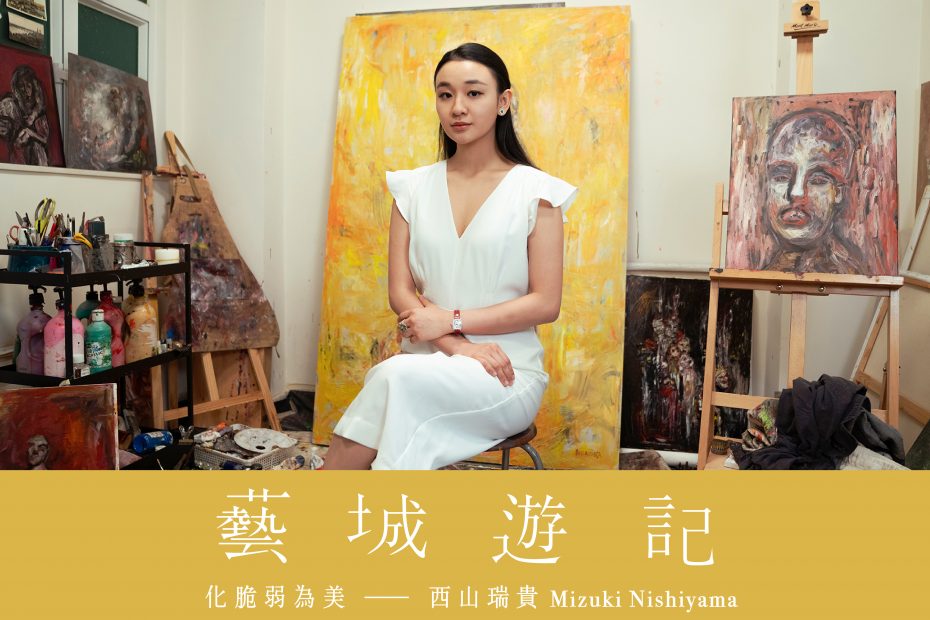Living in the generation of social media popularity, each individual’s life experiences have become more transparent. In order to gain acceptance, many people choose to selectively present their best side while hiding their vulnerabilities. However, behind all the glamour, everyone carries indescribable anxieties and traumas. Instead of refined appearances, Hong Kong-Japanese mixed media artist Mizuki Nishiyama is more fascinated by examining the most primitive vulnerabilities of humanity. She uses abstract expressionism to reveal themes such as human nature, cultural origins, gender norms, prompting people to confront pain and embrace imperfect reality.
At just 23 years old, Mizuki Nishiyama has a Hong Kong and Japanese heritage. Born into an artistic family, her mother and grandmother are both accomplished artists, while her Japanese father serves as the creative director of a fashion brand. Influenced by different visual aesthetics from a young age, Mizuki naturally embarked on the path of creation. Due to her family connections, she has spent years traveling between Hong Kong, Japan, New York, Italy, and other places to study and live. Growing up in this environment, she has absorbed the cultural nourishment provided by different cities like a sponge. Her work combines the cultural heritage of the East with the techniques of Western abstract expressionism, creating a unique artistic style.
Currently living in both Hong Kong and New York, she recently presented a solo exhibition “正座:感知與超越” at Art Next Gallery, continuing her exploration of human nature. Mizuki, who rarely stays in one place, is currently residing in Hong Kong. This episode of “Art City Travelogue” will take you inside this young artist’s studio, where you can delve into her creative ideas and artistic journey.
“Creation is a way of transformation for me.”
Mizuki’s studio is located in the bustling center of North Point, nestled next to the busy streets, yet her creative space exudes a sense of tranquility detached from the urban hustle and bustle. In the small space, there are many boldly colored abstract oil paintings, as well as numerous sketches. Upon first seeing Mizuki’s impactful oil paintings, one would never imagine that the creator is actually a delicate girl.
During the time spent with Mizuki, she always exudes a kind and elegant charm, and whenever the topic of creation is mentioned, she naturally enters a state of focus and seriousness. She mostly showcases a spiritual and intellectual exploration, just like her works, behind the unrestrained brushstrokes, she hopes everyone can take a moment to appreciate the insight into human nature behind the works.
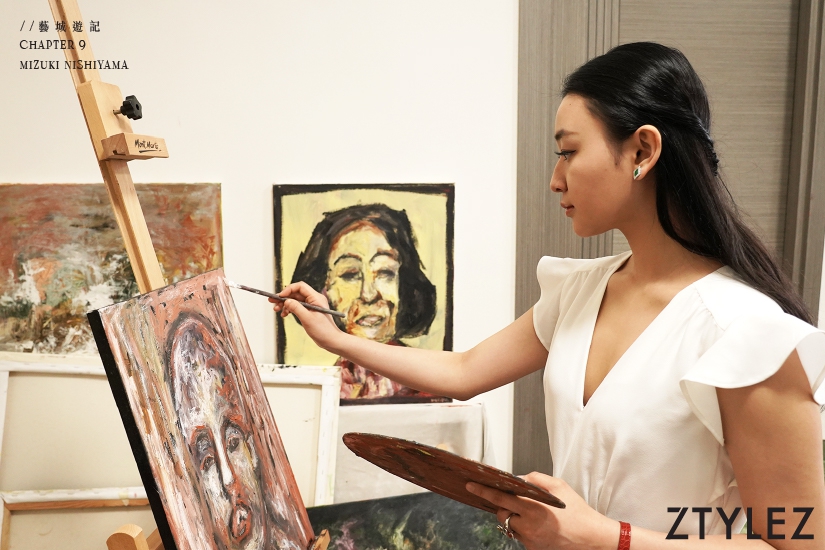
Mizuki’s creative inspiration often comes from the philosophical ideas and worldview she gained in Japanese culture. Due to her father’s love for exploring Western philosophy, she jokingly says she grew up in all sorts of strange stories. With her own love for literature and philosophy, she absorbs and digests more thoughts on life and gender through reading, writing poetry, and poses many questions about human nature.
Mizuki shared, “Many of my inspirations come from my identity as a Japanese person and a woman. I am very interested in my family history, the cultural heritage that has been passed down, there are different folk legends, the life experiences of ancestors, family values, and the insights from my parents. These things surround me and make me unable to stop exploring, it depends on how you piece them together.”
For her, painting is one of the ways to transform thoughts. She said, “Painting is the process of transferring thoughts, emotions, and experiences onto canvas. It is an internalization process where you must gather all possibilities from the outside world and understand the characteristics and conditions of each creative medium, whether it’s poetry, the alphabet in language, or musical notes. They are all the same in my eyes, just different ways for everyone to express themselves. So, in a sense, everyone is an artist.”
“My creative process is not refined, even a bit wild, but it is a record of life in the moment, unable to be replicated.”
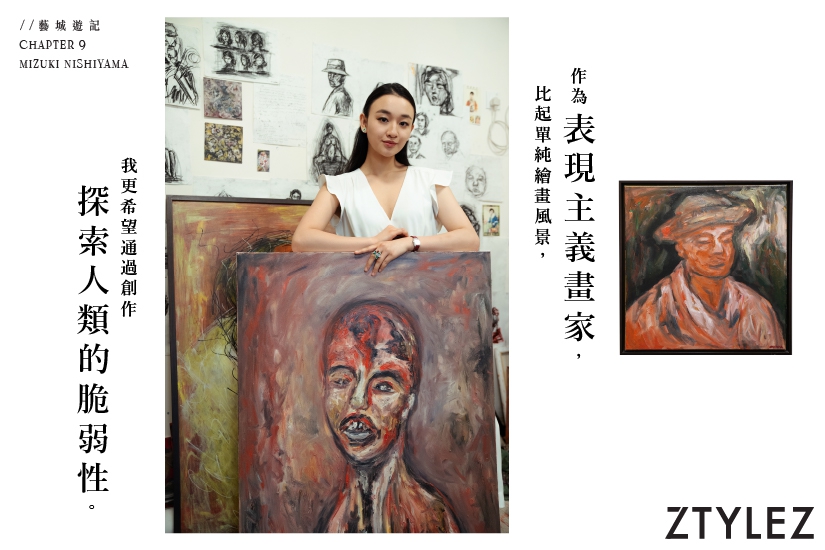
Due to its exploration of human vulnerability, fragility, and social and political ideas related to traditional and contemporary Japan, Mizuki’s work is often seen as a form of internal struggle, which she finds tormenting. Even Mizuki herself is aware that the themes she focuses on are more serious and profound. We are all curious about what has shaped her artistic style today.
She said, “As an expressionist painter, I don’t just paint landscapes of the sea and sky. Of course, I can do that too, but I prefer to delve into deeper art, to explore the more aggressive side of the inner self, to showcase the ugly side of human nature, even though it’s not always a calming subject.”
Regardless of the type of creation, the work always reflects the creator’s subconscious and is a process of self-description. In describing her journey in painting, Mizuki admits that her creations have not always been refined, and the exploration process has been accompanied by daunting pressure. However, what is valuable is that each creation is a record of that moment in life. Even if she were to pick up the brush again in the future, she cannot replicate the fleeting brushstrokes, which is something she highly values about the uniqueness of creation.
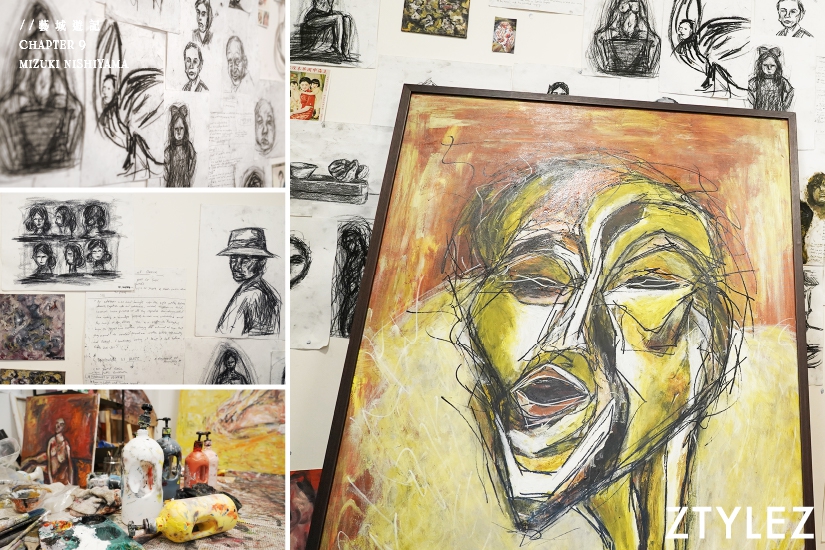
In Eastern culture, society advocates collective consciousness, while in Western culture, they value individual uniqueness more. Mizuki has studied in both Asia and the United States in the past, and this conflicting set of values constantly challenges her. Especially as an Asian woman, the suppression she has experienced during her upbringing has left a deep impact on her. Amidst the ideological opposition, she may have experienced many moments of self-doubt, but in the cycle of being knocked down and self-healing, she has never stopped exploring humanity, culture, and more.
She calmly said, “When I was young, I encountered some doubts about the limited life, my female identity, my values, philosophy, etc., but for me, managing my own anxiety and trauma well can make us more empathetic in the process of growth.” When beliefs that have always been believed are questioned, it is definitely not easy, but in the words of this young artist, there is no resentment, but thinking about transforming trauma into a driving force for personal growth. This tolerant attitude may be the broad-mindedness that creation gives her.
“If I don’t paint, I might not be able to survive.”
When Mizuki was young, she witnessed her mother and grandmother documenting their own journeys as women through creativity, and drawing became her way of dealing with pain. From perceiving life, internalizing emotions, to recording with a paintbrush, it is a slow process of sedimentation. Mizuki shares with us that she spends several months in different places throughout the year, and a few months ago, she stayed in Japan for three months, allowing her to immerse herself fully in her ethnic culture and family life. Because her creative base is in Hong Kong, she cannot carry tools and materials with her, so the only things that can accompany her are probably notebooks and drawing boards.
She showed us her essays, densely filled with words, some of which were impromptu poems, while more were full of profound academic inspiration. Although she claimed her creations were more unrestrained, in reality, they were supported by profound philosophical and academic ideas, giving her work such a powerful impact.
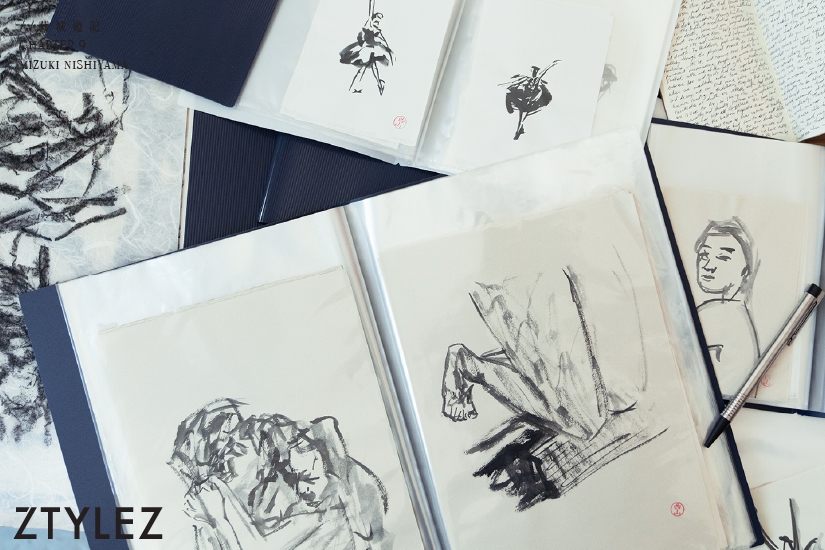
Mizuki said, “I have a very academic side, I enjoy spending time researching, and recording my thoughts in writing to ensure that I can create meaningful themes. When I return to Hong Kong, I will freely express my previous ideas on the canvas. Looking back on the past is always exhausting for me. I know this is not good for my mental health, but creating art allows me to get closer to myself and reality. When my thoughts are finally displayed in beautiful images, I feel satisfied. Painting always has a special therapeutic effect for me.”
Witnessing the perseverance of family members in pursuing their creative passions to this day, Mizuki has long viewed creation as a lifelong career. When asked how much she enjoys painting, Mizuki, who has been talking all the way, fell into a moment of silence. She said, “The values and goals I think about every day are very clear. If I don’t paint, I might not be able to live.” With the education from her native family and the blessing of artistic talent, painting has always been closely related to her. Perhaps since she became conscious, creation has always been inseparable from her, it is already innate, making her feel like a complete part. Rather than a brief explanation, she prefers to let her work speak for itself.
“I hope to use this exhibition to examine the expectations imposed on my gender and culture, and explore the liberation of being a Japanese mixed-race woman.”
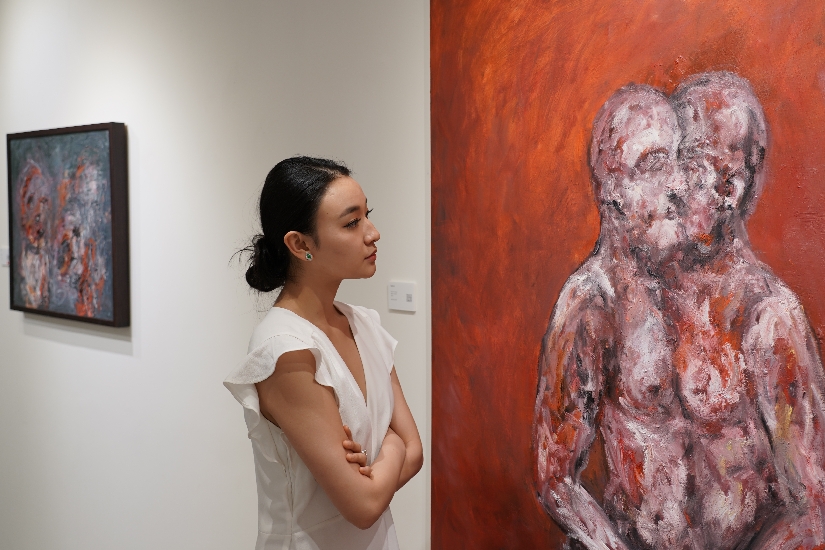
Mizuki expressed her excitement about showcasing her latest solo exhibition “正座:感知與超越” at the new art gallery in Hong Kong. This exhibition is themed around the traditional Japanese sitting posture, which requires sitting upright with hands placed neatly on the knees, highlighting a dignified and courteous demeanor. Influenced by the ancient Eastern belief of “men superior, women inferior,” only men are allowed to sit cross-legged in a Japanese tatami room, while women are expected to sit in a strict kneeling position according to etiquette. For Mizuki, this is a very humble and reserved posture, yet it carries underlying norms for women.
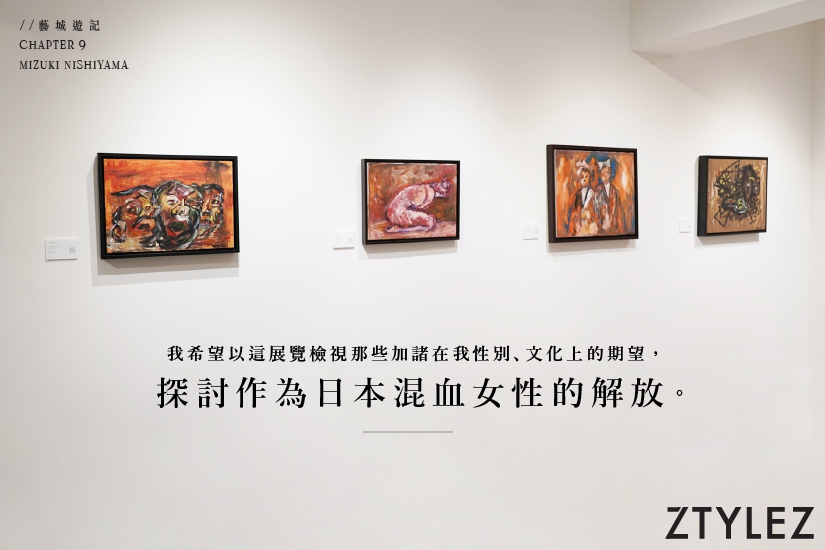
The exhibition’s works start from the perspective of “female gaze,” and Mizuki boldly discusses questioning Japanese traditions and observing human nature. She said, “I hope to correct these concepts, correct the expectations placed on my gender and culture, and explore the liberation of being a mixed-race Japanese woman. What I focus on is human nature, my own experience as a woman, as a human being.”
When asked about how she hopes her work will impact the audience, Mizuki stated that it is a personal way of recording for her. She has no intention of imposing her thoughts on anyone, but rather hopes to reflect on traditional constraints and showcase the various aspects of human nature through her work. She believes that we should maintain an open attitude, accepting that everyone has a less dignified side, which allows us to explore new perspectives. Perhaps, at some point in the future, this could turn into a driving force that propels us forward.
“Every time I travel abroad and return to Hong Kong, I feel a sense of belonging and security, that’s the feeling of ‘home’.”
In artists, we see not only cultural diversity but also a level of ideological inclusiveness. Mizuki has traveled around for many years, joking that she can discover different aspects of herself in every place. She describes the bustling New York as having something new happening every moment, with no set rules teaching you how to survive in this place. The subsequent unknowns provide her with a lot of inspiration for her creations. In contrast, in the relatively rule-bound Japan, she sees many moral codes passed down from her own ethnic traditions, which constantly make her ponder the norms of gender in contemporary society and attempt to break free from various constraints through her creations. So, what kind of existence is Hong Kong for Mizuki?
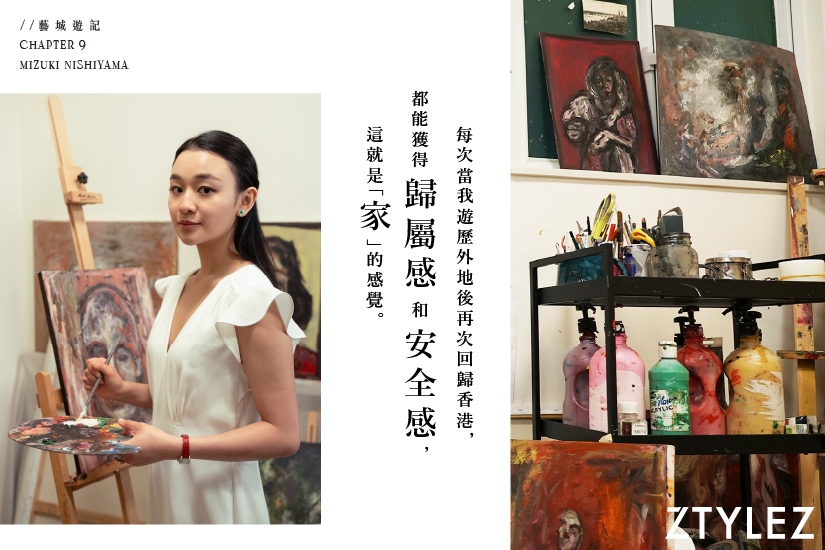
She responded, “This city has some very tolerant aspects that make me feel very flexible and comfortable. I may stay in different places for a long time for different reasons, but I am happy that every time I come back here, I feel a sense of belonging and security, I think this is the feeling of home.” If traveling abroad is about collecting inspiration, then returning to Hong Kong is the base for her to sort out emotions and fully engage in creation. Hong Kong has become a place of belonging for Mizuki, precisely because she has a place to anchor herself, her creative path has gone further.
Mizuki believes that the essence of Hong Kong is as thick as honey, with a variety of rich nutrients concentrated in a small jar. She finds the pace of life here fast and able to provide everything she needs, but as an artist, she is well aware that creativity does not prioritize efficiency; it is a precious process of self-deposition. Even though she sees this place as a creative base, she does not conform to the fast pace of life here, but instead insists on her own creative rhythm. She describes it as a painter diluting thick paint with water to blend the colors into a smooth texture, and for creators, inspiration should also be combed through with time so that the resulting work is more complete, and this painting workspace in Hong Kong is just like that.
“The inspiration around me is endless, I will continue to explore.”
In addition to her latest solo exhibition, Mizuki’s recent works have also been continuously featured in art group exhibitions in Japan, New York, Hong Kong, and other places. As her presence in the art world gradually shines, just when we thought she would fully devote herself to the art market, she shares with us that she will continue her artistic pursuits in London in September this year. As a rising star in the art world, her career is also at a peak, and we are all curious why she chose this time to go to a relatively unfamiliar city to continue her academic pursuits.
Mizuki firmly stated, “I have always known that I will continue to explore knowledge. As I mentioned, in addition to creating madly, I also need a meditative state. I enjoy researching, learning, reading. I find inspiration from different artists and philosophers, and their groundbreaking ideas help me understand my identity more.”
Indeed, Mizuki has always been showcasing different aspects on her creative journey. In addition to her most frequently painted expressionist oil paintings, she also has figure sketches drawn with charcoal and ink. Apart from the sketches on the studio walls, she showed us several folders, containing her systematically organized different ink series. In addition to her recent figure works, there are also her recent creations studying the “nine stages of human body decomposition,” surprising people with the wide range of her painting subjects.
She said, “You need to feel small, you need to feel humble to some extent. Because there are still many unknown things ahead of me, I hope to face these unknowns with grace and confidence, which is what I consider living a rich life.”
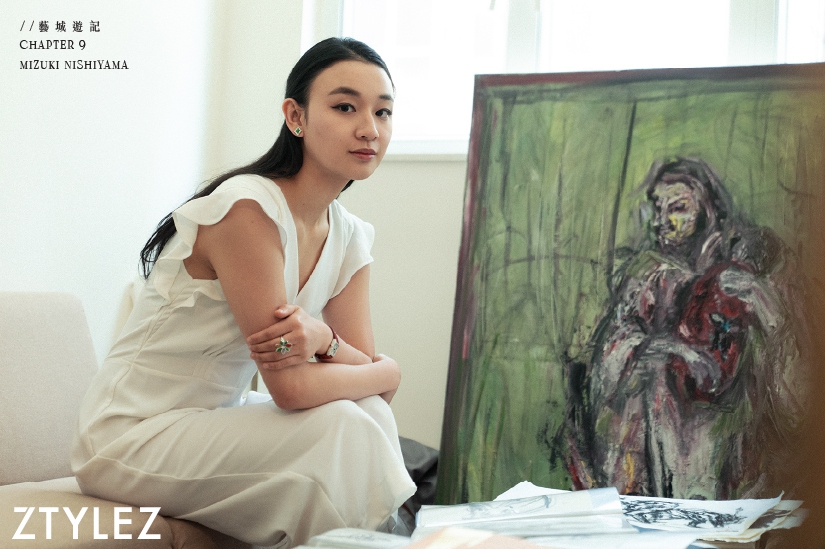
Two weeks after the interview, Mizuki will fly to London to participate in an artist joint exhibition, showcasing works revolving around themes of humanity and female empowerment. In her, we do not see the innocence of a twenty-year-old, but instead a sense of independence, composure, and wisdom beyond her years. Through her works, we see the fragility of human nature, as well as moments of realization that resonate with us. Behind the abstract strokes, there seems to be a silent message being conveyed: we must learn to love the darkness in life.
Outstanding works often have a mysterious quality, Mizuki looks at the essence of human nature through painting, observing, and learning, which may not necessarily be critical, but rather reveals the vulnerability and pain that everyone cannot express, and tries to transform it into beauty, abruptly stopping, leaving a lingering feeling.
Pain will eventually pass, but the beauty of art will remain forever. Looking forward to this rising star in the art world to continue capturing the light and shadows of life and learning, turning them into more paintings that examine life and move the soul.
Executive Producer: Angus Mok
Producer: Vicky Wai
Editor: Ruby Yiu
Videography: Andy Lee, Angus Chau
Photography: Andy Lee, Angus Chau
Video Editor: Andy Lee
Designer: Edwina Chan
Special Thanks: Mizuki Nishiyama ; a|n Gallery

